
Re-posted from my original article, also featured in Age of Awareness (Medium).
Background
For my Design Methods class in Winter 2018 (via UW Information School, MSIM Program), I worked with my project partner, Nathan C., on a project about engaging students with disabilities in STEM. Nathan and I worked on two different prototypes to address issues that contribute to the challenges faced by students with disabilities in STEM classrooms. My project partner and I conducted a number of contextual inquiries with academic administrators in a university setting, community members who are engaged in youth STEM programs/activities, and teachers.
For more information about our overall project, please watch this video: Engaging Students With Disabilities in STEM Education (YouTube, 3 minutes).
Flashcards for Universal & Inclusive STEM:
This post will focus on the prototype I worked on, Flashcards for Universal & Inclusive STEM. This prototype is a stack of flashcards meant to encourage and provide considerations for educators when designing or implementing their STEM curricula. The Flashcards are meant to work with both structured and semi-structured school and community settings. I worked on a low-tech prototype (flashcards) to support teachers, faculty, volunteers, and community members engage students with disabilities in STEM settings.
Design
For this prototype, I chose to include principles tied to Universal Design and specific considerations and accommodations tied to four types of disabilities: Hearing, Communicating, Movement and Vision (Picard, 2016). I came up with a list of considerations because they are often the most noticeable, and actionable through inclusive curriculum design. In addition, I added considerations tied to students with Limited English Proficiency.
Process
I referred to UW Disabilities, Opportunities, Internetworking, and Technology (UW DO-IT) and AccessSTEM for examples of Universal Design principles. I started by compiling a list of Universal Design principles and list of various accommodations associated with types of disabilities chosen. Using an affinity diagram, I organized elements into the different categories (See Figure 1).
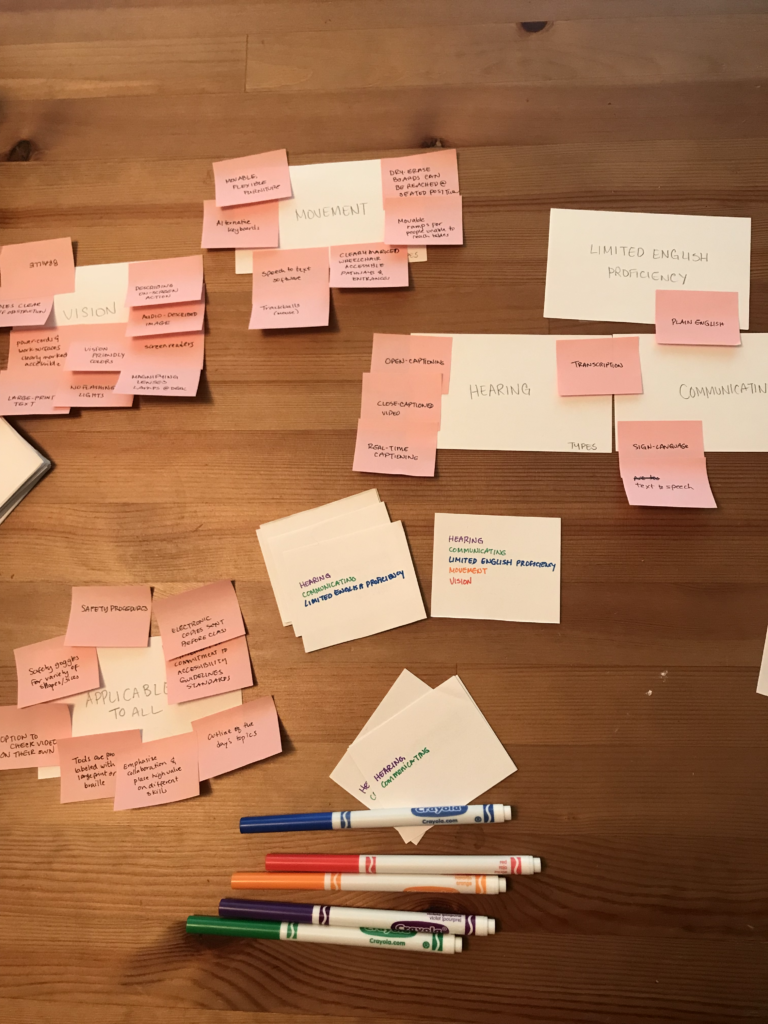
I identified elements that can impact different groups of people, e.g. students who have difficulty Hearing and Limited English Proficiency may both benefit from closed-captioning. For students with Limited English Proficiency, the ability to read (in addition to hearing) words spoken could enhance their ability to comprehend what is happening on the screen. Each element (Universal Design principle or specific accommodation based on disability) were written on one side of an individual index card (see Figure 2). A list of terms used can be found in Figure 3.
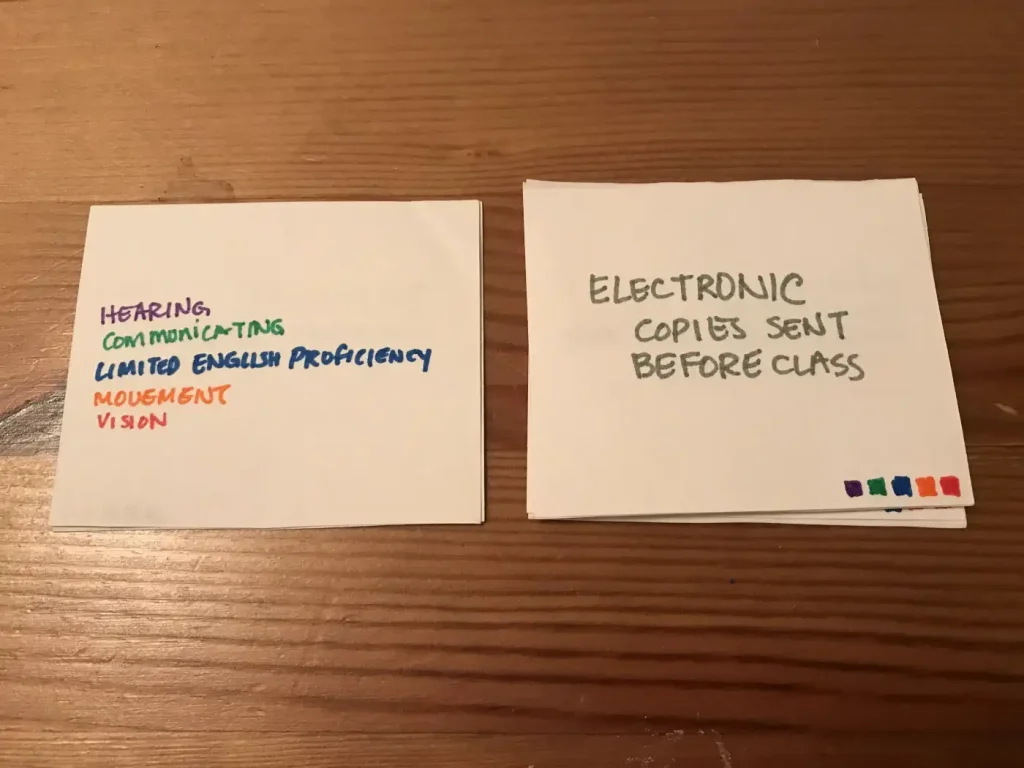
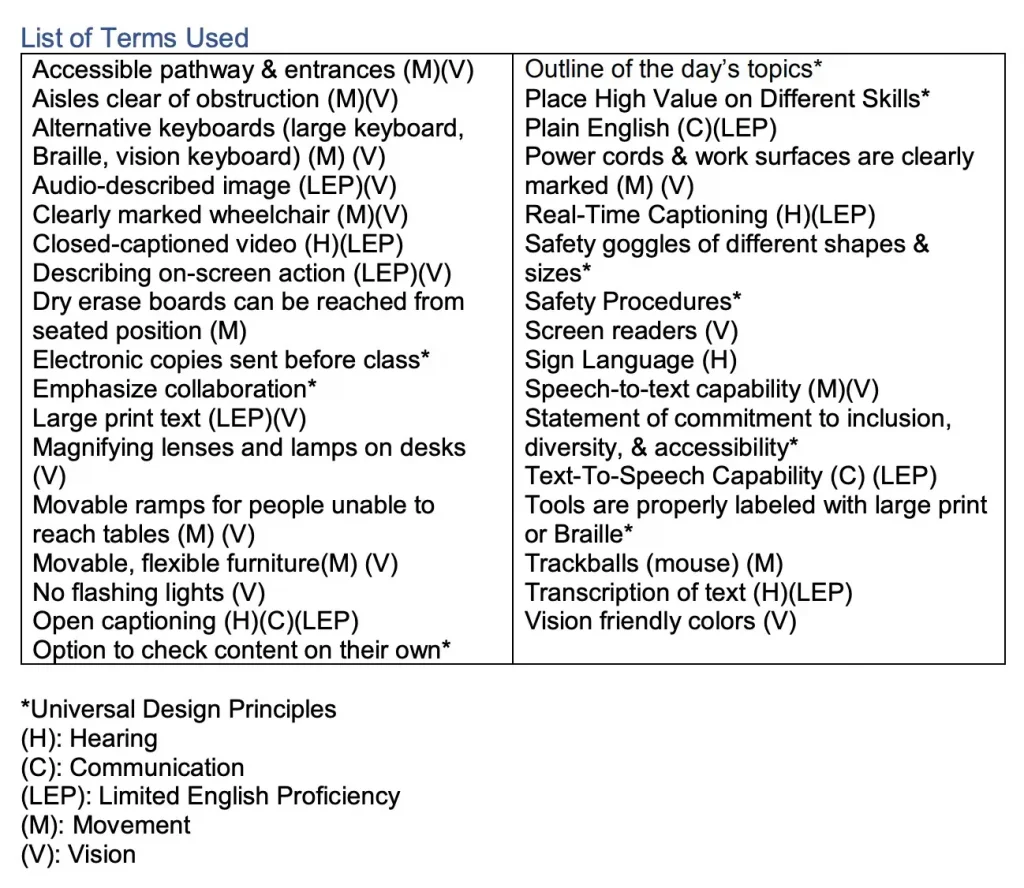
Design Specifications
I used 3.5in x 5in index cards which were cut in half (see Figure 4)
Legend
Violet (Purple): Hearing Green: Communicating Blue: Limited English Proficiency Orange: Movement Red: Vision Gray: Activity Light Gray: Inactive Font Face: Helvetica

Usability Testing
Purpose
The purpose of the test is to determine overall effectiveness of the flashcards in developing inclusiveness and incorporating Universal Design principles in the classroom.
- Assess effectiveness of the flashcards in guiding participants process Universal Design principles while completing tasks related to each scenario.
- Identify challenges and opportunities to improve the prototype.
Methods
The method for testing usability of the flashcards was meant to be exploratory. There were 5 participants total. Participants have varying backgrounds in teaching, facilitating, and working with students and asked them about their familiarity with different types of disabilities in order to determine whether the flashcards provided them with new information about students with disabilities and their challenges in STEM classroom settings.
Each session was 45–60 minutes long in an informal setting with minimal noise in order to effectively conduct an audio recording. I conducted 4 sessions total. I observed participants perform tasks and assess the effectiveness of flash cards for each scenario. I asked each participant to Think-Aloud as they go through their individual processes for a scenario.
Scenarios
Scenario #1: You have a student who communicates using sign language. It’s the first week of school and you want to host a “show & tell” activity to your students. For this activity, plan to have your students present a short “show & tell” presentation of what they did over the summer using a medium of their choice, e.g. Powerpoint, video, poster, etc.
Scenario #2: You have international students and a student with low-vision in your science class. For a class session, you plan to show a 5-minute video on YouTube about STEM.
Scenario #3: A student in a wheelchair is in your math class. Design a group activity where: students complete a set of math problems as a group, using a sheet of paper to document their work that they will submit at the end of the class, then elect a representative to solve one of the problems in front of the class using the dry-erase board.
Observations
Session 1, Participant 1: Scenario 2
No prior experience teaching or facilitating workshops or designing, familiarity with hard-of-hearing and deaf students, knows American Sign Language.
Spent significant time to determine appropriateness of the video content to be displayed or contextualized properly.
Brought up the idea that classroom locations may not be part of the curriculum design process, since teachers typically will have already assigned rooms.
For Session Two, Participants 2 & 3 worked together on Scenario 1:
Participant 2: More than 2 years experience teaching & designing curriculum, consultant Applied Behavior Analysis (autism and other behavioral disorders)
“Now that I’m looking at these cards, it’s just like… amazing how much we need to consider all the time. What if we don’t know? What if they don’t say anything?”
“If you have [these flashcards], it makes you much more aware… like a toolkit or a checklist of things to consider.”
Participant 3: More than 2 years teaching and designing curriculum, currently a teacher
“How is the child going to tell what or how their peers are doing? What if they don’t do sign language?”
“You think you’ve considered everything… oh wait, maybe I should’ve thought about that.”
“Having a checklist is great, but this is kind of fun to have cards — it’s like a physical thing I can manipulate, prioritize, and arrange instead of just having a sheet of paper.”
Session Three, Participant 4: Scenario 2
Less than a year experience in teaching or facilitating, no experience or familiarity of students with disabilities
“Our classes are kind of like drop-ins… more informal.”
“I just come in to teach the coding part so I don’t really think about these.”
Session Four, Participant 5: Scenario 3
Two or more years in teaching and facilitating, 1–2 years in working with students with disabilities
“Sometimes, we don’t have a lot of say in the location or the type of space we get, so it would be hard to know how plan.”
“We don’t really know who will show up.”
“You know how hard it is to train volunteers… specially with specialized software. But this is helpful to think about.”
Findings
- Teachers and facilitators who have had experience teaching and facilitating consider the range of tasks they have to do when designing their curriculum. One participant claims that going through the cards “almost makes you feel guilty because [she] doesn’t make sure her classroom has [accommodations described in the cards.”
- Teachers often collaborate in curriculum design. For session two, participants divided the stack of cards and each sorted out an equal number of cards while checking in with each other about individual cards. At one point, they switched their stack of cards for the other to conduct a second look.
- Participant 3 pointed out to how some terms are “clear” to her because she is college-educated, but may not be true for everyone working and teaching, especially those in Early Childhood Learning. This reinforces the need to add definitions for the terms, as suggested by Participant 1.
- Participant 3 begins to consider how her role as a teacher often requires her to figure out if students have disabilities (if they don’t self-identify), and that she often has to make “inferences.” She always tries to be proactive and accommodating.
- Overall, the participants saw the value and helpfulness of the flashcards in helping them consider different types of considerations when working with students with disabilities (1 rated 5 = very useful, 3 rated 4, 1 rated 3).
Prototype Evaluation and Iterations
Participants were asked about values they considered important in flash cards or card sorting activity or games they have used in the past, which included Size, Portability, Readability, Colors, Context, Relevance, Feel & Weight. Using these values, we asked participants to evaluate the effectiveness Flashcards for STEM in accomplishing the tasks implied by the scenarios they were given. The value “Context” received the most suggestions (4 out of 5 participants), followed by “Readability” and “Relevance” (3 out of 5).
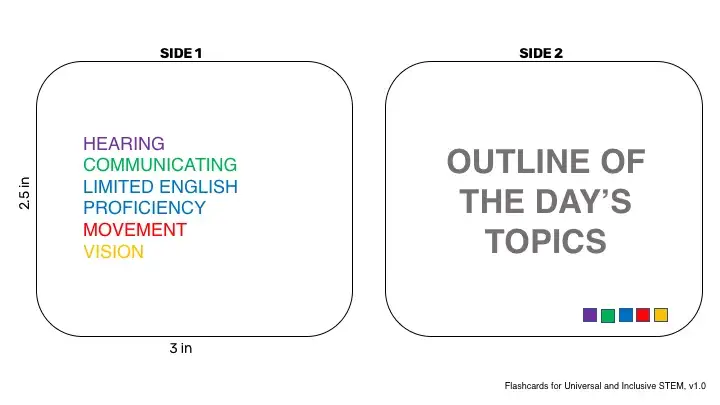
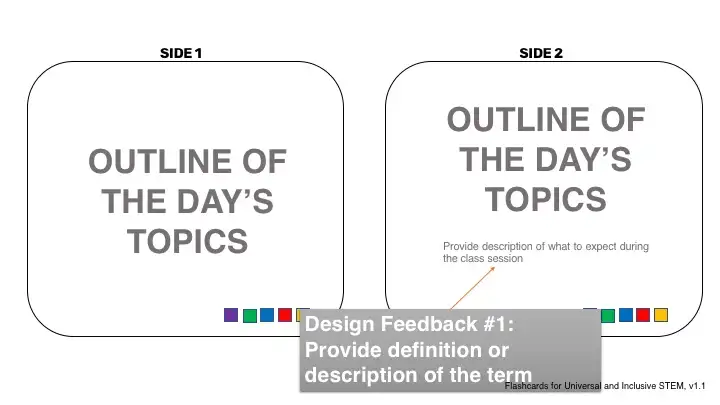
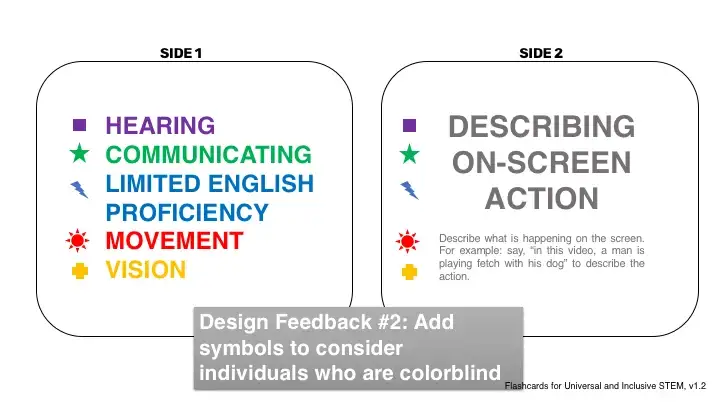
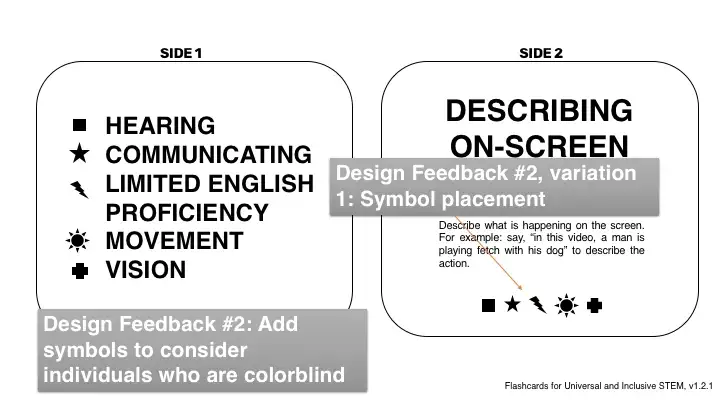
Conclusion
Teachers and facilitators are critical in creating a welcoming and inclusive STEM learning environment, but they often face challenges in doing so — whether from lack of training or familiarity with students’ challenges or lack of funding to consider accommodations.
Using Universal Design Principles, I designed a low-cost, low-tech set of flashcards to assist teachers and educators design and implement their STEM curricula. Through small evaluation sessions, I observed that the use of flashcards helped participants become aware of Universal Design Principles in curriculum design, and that it was an effective tool in provoking thoughtful considerations that could help improve inclusivity for students with both seen and unseen disabilities.
Initial prototype designs received positive feedback (general intent and helpfulness of flashcards). Feedback consisted of improvements to the visual and context aspect of the flashcards as a whole.
Thoughts and Reflections
I believe that future iterations of the flashcards and potential study of whether the use of aids to support Universal Design Principles is effective in both structured and semi-structured settings. I’d love to see this type of project evolve and catch on.
Let me know your thoughts! I would love to collaborate!
